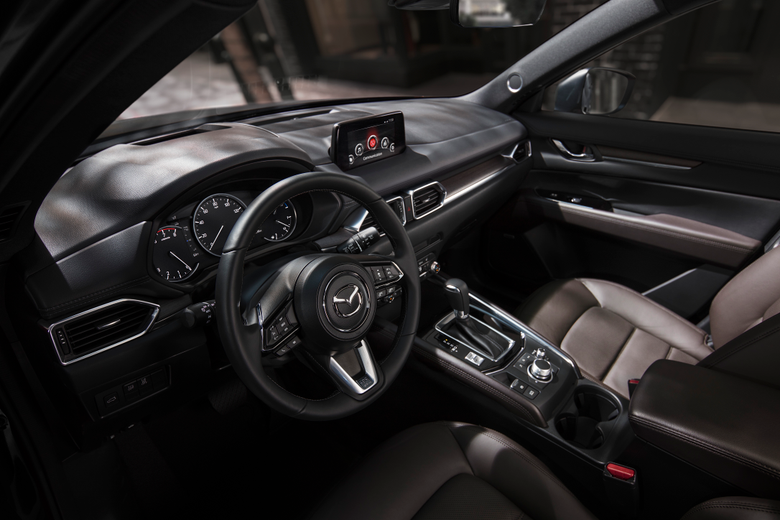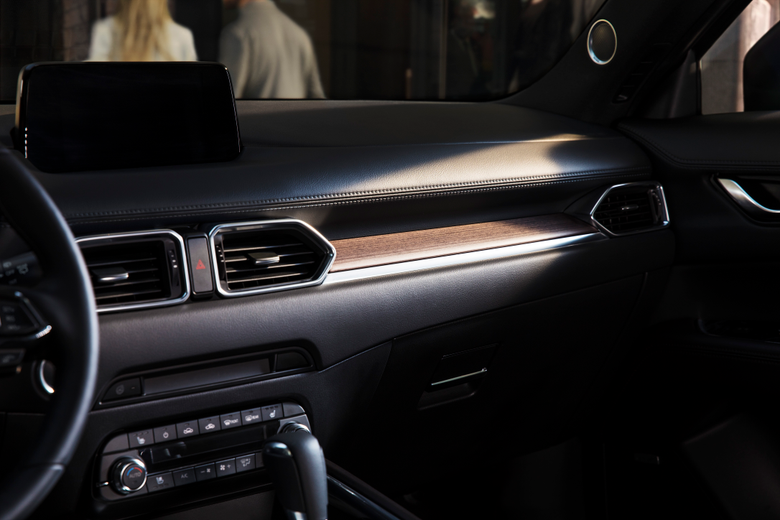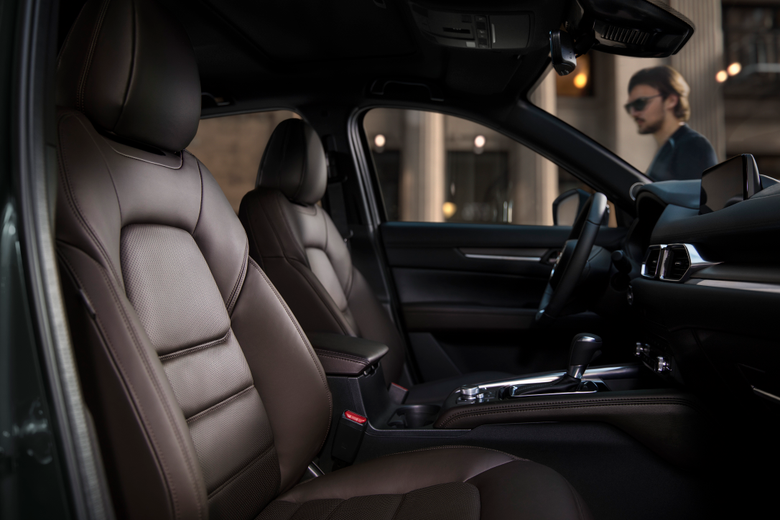The 2019 Mazda CX-5 Diesel Is Too Little, Too Late
We've been hearing about the Mazda Skyactiv-D diesel engine for about 10 years. Now it's finally, here in the 2019 Mazda CX-5 diesel. It's a nice idea and the car itself is not bad to drive. I just don't see many people buying it.
Who is this car for? Why does it exist? These were questions echoed by many of you when I asked you what you wanted to know about it. They are logical and fair questions to ask.
(Full Disclosure: I wanted to try out the 2019 CX-5 diesel, so Mazda loaned me one. I drove it all over New England over the course of about 10 days.)
Perhaps if the diesel CX-5 came out for the United States market 10 years ago, its niche would have been unique. More purposeful. But now, in 2019? I'll repeat the words of the great Stanley Tucci from Burlesque here: "Great enthusiasm, terrible timing."
What Is It?
For those of you not in the know, I'll be brief. There have been a number of promises for a diesel-powered car from Mazda for the U.S. over the years. One happened in 2010 for a planned 2012 debut, which didn't happen. After, there was a diesel Mazda6 at the 2012 LA Auto Show, which was ultimately delayed until 2014.
And then that whole Dieselgate thing happened.
But Mazda kept at it. In 2016, it promised yet again a diesel CX-5 would appear in 2017, but that didn't actually wind up happening until April of 20-freaking-19. So that's where we are now.
On the outside and in the cabin, it's a regular CX-5. It's an egg-shaped crossover that seats five and is easy to climb into and get out of. Beneath the hood is a diesel motor that's quiet and supposedly torquey in practice and more efficient than a regular gasoline engine.
Specs That Matter
Mazda's Skyactiv-D is a 2.2-liter, twin-turbocharged diesel engine that produces a claimed 168 horsepower and 290 lb-ft of torque. This doesn't sound like a lot of juice on paper, but then again, diesels are not really known for their mind-blowing HP figures. What I wanted to experience is the torque everyone keeps talking about. More on that later.
According to the EPA's estimates, the CX-5 diesel will get 27 mpg in the city, 30 on the highway and 28 combined. Since mileage is the biggest draw of this car, I went ahead and tested it out myself.
What’s Great
Similar to all Mazdas on sale right now, the CX-5's interior materials punch above the car's weight. You'd very easily think you're riding in something much more upmarket if you weren't paying better attention. The cabin design, leather and wood trim all exhibit a sense of quality and restraint. Nothing is overtly flashy, shiny, reflective or cheap-feeling.
It's a spacious car, with a cabin well-thought-out and airy. What's also wonderful is how quiet it is. The diesel engine makes a bit of drone during acceleration, but once that business is over, it quiets down into a barely perceptible hum.
The seats are also comfortable for long highway trips. I heard no complaints from my rear passenger about legroom or stiffness on a trip from Worcester, Massachusetts, back down to Manhattan.
What’s Weak
Trunk space, which measures 30.9 cubic feet with the rear seats up, is a little smaller than a competitive Toyota RAV4's, which offers about 37 cubic feet. A week's worth of luggage for two (a medium-sized rolling suitcase and a duffel bag), plus some backpacks and groceries fit just fine, but when we introduced a third person and their luggage, some of it had to ride in the rear passenger seat.
The car is also very slow. I'd heard from a fellow journalist the CX-5 diesel had just enough power to get out of its own way, but even that seemed generous when I actually got to drive it. Pieces breaking off of Pangaea would probably win a drag race. Other cars with similar power figures—the Toyota RAV4, the Camry, the Cadillac XT4—all felt like they could blitz the CX-5.
Perhaps the car needed a manual. (Which car doesn't, truly?) Perhaps with a manual, I'd be willing to forgive the molasses acceleration because the torque would be there to help with taking off from a stop.
Once you're done losing races to tumbleweed, then there's the issue of filling up. Most gas stations carry diesel fuel, but there are definitely a few that don't. Your odds of running into one of these is probably quite low, but it can still happen. It happened to me. I pulled up to a gas station and they didn't sell diesel. This isn't really the car's fault, though. It's just inconvenient.
Casual Driving
I really liked the CX-5 as a commuter car. I offered myself up as errand runner as frequently as I could just to be able drive it around more. It's a very pleasant thing to do, drive the CX-5 diesel around town.
The steering is on the lighter side, but not completely numb. You don't feel like you're blindly stabbing at the road when you make a turn. The transmission shifts smoothly and won't jar you. And visibility was decent, even when looking over your shoulder.
Everything boiled down to the CX-5 being very agreeable. Some cars will draw attention to themselves with sensitive brake pedals, loud engines, clunky transmissions or harsh ride quality. This all from a very "you don't notice it until it screws up" mentality.

In that regard, the CX-5 is invisible. You feel like all the work is being done behind the scenes and the most you witness is the landscape passing by. It's a pretty seamless daily driver where nothing really upsets passengers (not even acceleration, which is a good type of upsetting). All tactile inputs are dialed in to just give you enough information, but not too much to be impolite.
Real-World Mileage
Between getting the car delivered, resetting the trip and mileage counters and filling up for the first time, I logged 417.9 miles and purchased 12.958 gallons of fuel for Trip 1.
After going 402.9 miles further, I filled up a second time with 12.284 gallons of fuel for Trip 2. And before giving the car back to Mazda, I logged 127.5 miles and the car's mileage counter reported an average of 33.9 mpg for Trip 3.
Here's a chart:
As you can see, I averaged a total of 33 mpg from real-world driving conditions. That is to say, I took the car through New York City, went on some very long highway stretches, sat in rush hour traffic and ran some errands in a suburban environment. That's better than the 28 combined mpg figure the EPA came up with.
Analysis Time
So, 33 mpg combined. That's not bad, right? Certainly not when compared to the 26 mpg combined from the normal, gasoline-driven CX-5. But here's the diesel CX-5's biggest problem: hybrid cars exist.
The rise of good and efficient hybrid cars that people actually want to buy is a pretty recent phenomenon. They no longer include just the Toyota Prius, which you either love or hate the look of. Now, there's the Honda Accord hybrid (EPA-estimated 48 mpg combined), Hyundai Sonata hybrid (EPA-estimated 42 mpg combined) and Ford Fusion hybrid (EPA-estimated 42 mpg combined).
True, the Toyota Highlander hybrid only gets an EPA-estimated 29 mpg, but that's a much larger car. The comparable Toyota RAV4 hybrid gets an estimated 39 mpg combined. And now that the Honda CR-V hybrid and RAV4 plug-in hybrid have both been announced, it sort of begs the question of why any automaker is bothering to sell an efficency-focused diesel in 2019 at all.
Value
The CX-5 diesel is not cheap. Its base price starts at $41,000, but after a handful of optional equipment, my loaner came out to $44,335. By comparison, a regular, base CX-5 starts at around $25,000. The additional 20 grand gets you all-wheel drive and combined fuel efficiency that's really only marginally better than the gasoline version's.
As for the RAV4 hybrid? That car starts at $28,100, has more trunk volume and gets better mileage. I cannot imagine anyone would see these figures and still shell out extra for the diesel CX-5, unless they were a weird nerd or European. Sometimes these are not mutually exclusive.
Verdict
I appreciate that the CX-5 diesel exists. Variety is nice, and this is a nice idea. Agreeable as a daily driver, it has an impressively quality interior, too. Also, props to Mazda for building a diesel car that, you know, doesn't cheat. (We think.)
But I also can't shake the feeling this car sort of missed the boat. Had it come out 10ish years ago like it was supposed to, it probably would have had a fighting chance, since hybrids weren't as prevalent and diesel's reputation hadn't been messed up beyond repair yet.
Ten years ago, people could still buy a Hummer. That was the time to strike.
Look, I know there are people out there who don't care about anemic engines. They prioritize efficiency over acceleration and silly stuff like that, so they wouldn't have the same gripes about the CX-5 diesel's performance as I did. But what reason would those people have to buy the Mazda when plenty of better hybrid cars are readily available for less money?
Mazda is also planning a Mazda6 diesel for a little later on. I'll wait and see the EPA mileage estimates when they're made public, but I won't hold my breath. The diesel 6 will go up against some tough competition.
And as for this CX-5 diesel? Good car, but maybe it should have been a hybrid.










